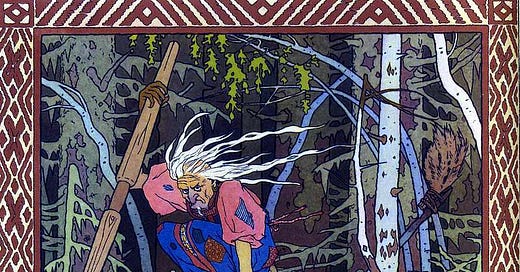My youngest loves to watch a group from Kyrgyzstan, D Billions, that is full of bright, colourful characters who sing and dance to catchy numbers. After one of his watching sessions, he ran to me doing what he called a ‘Poppa Yaga’ dance. So I curled up next to him and asked him to show me what he’d been watching - had my YouTube filters somehow gone awry?
Nope, there were the usual four bright characters, but this time they were lost in the woods, before finding a seemingly welcome cottage as shelter, reminiscent of Hansel and Gretel tales familiar from my own childhood. They pigged out so much on the food set out on the table, three of the four turned into pigs and ended up in the roasting pot! Thankfully, this is a kids channel, so it was all done in a gentle and humorous style - a happy ending courtesy of a magical stringed instrument called a balalaika. What surprised me most was that the witch whose house the four had invaded was indeed Baba Yaga!
It had been a long time since I read or heard anything about Baba Yaga, and I’m certainly no expert on this Slavic legend, but I certainly didn’t remember anything about doing a short song and dance routine as she turned entertainers into her dinner. Perhaps my memory was doing me a disservice, so I started to read a little about her origin story.
No house of gingerbread here, Baba Yaga - who is either one witch, an ogress, or three sisters, depending on the version one reads - lives in a hut that moves around the forest on chicken legs. She rides around in a mortar, holding a pestle, and sweeps a broom behind her to hide her tracks.
What is fascinating to me is the moral ambiguity with which Baba Yaga is described. She is certainly the saviour, of sorts, in some tales. Yet she extracts a gruesome price when she agrees to help visitors to her hut. She is sometimes likened to Mother Nature. Yet other tales have her as a cannibal, kidnapping and eating children. There are certainly similarities between some iterations of Baba Yaga and the witch in Hansel and Gretel, and I wonder what other tales share such kindred inspiration from around the world. Perhaps I’ll set aside some time one afternoon soon to do some research!






